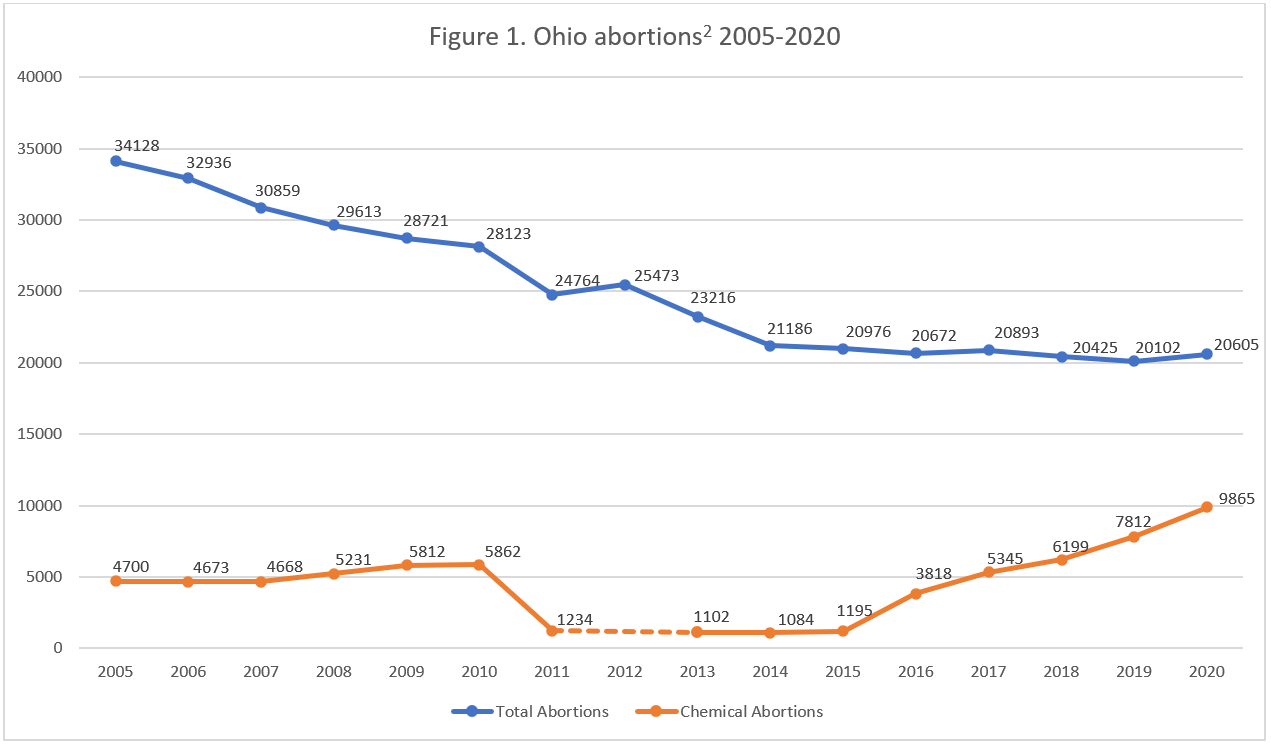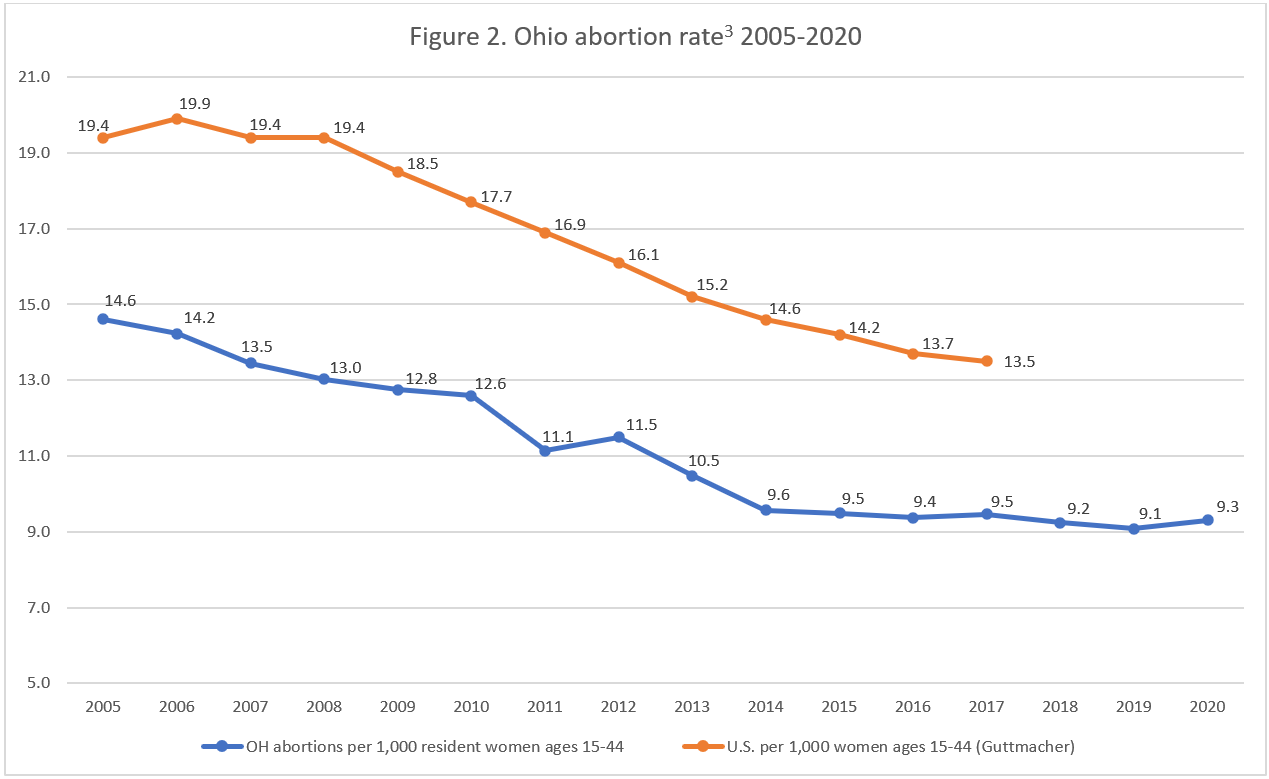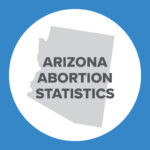Abortion Reporting: Ohio (2020)
Ohio’s 2020 abortion report was published in October 2021 by the Ohio State Department of Health. Ohio abortions increased from 2019.
Changes in Ohio Abortions, 2019-2020

The report does not include information on Planned Parenthood’s Ohio abortion market share.
Abortion Totals and Trends
In 2020, there were 20,605 abortions reported in Ohio, an increase of almost three percent from 2019 (Fig. 1). Chemical abortions jumped 26 percent from the previous year, making up 48 percent of the state total in 2020. Ohio’s 2020 abortion rate was 9.3 abortions per 1,000 women of childbearing age, as estimated by the Charlotte Lozier Institute (CLI) (Fig. 2). By March 2022, 29 states had released 2020 abortion reports, of which 19 showed that abortions had increased from the year before.
State Report Summary
The vast majority of Ohio abortions (94 percent) were reported to have been performed on resident women, while six percent were obtained by nonresidents. Nine percent of Ohio abortions were performed on girls under age 20, and 59 percent were performed on women in their twenties, with 29 percent on women ages 20 to 24 and 31 percent on women ages 25 to 29. Twenty-nine percent were performed on women ages 30 to 39, and three percent were performed on women ages 40 and above.
Eleven percent of Ohio abortions were on women who had not graduated from high school, and 38 percent were performed on women with a high school diploma or its equivalent as their highest level of education. Twenty-two percent were on women with some college but no degree, and 20 percent were obtained by women with an associate degree or more. Education was not reported for eight percent of the abortions performed in Ohio.
Eighty percent of the abortions were obtained by unmarried women, and 13 percent were performed on married or separated women. Marital status was unreported for seven percent of the abortions. Twenty-one percent of the abortions were on women with no previous pregnancies; seventeen percent were performed on women with one prior pregnancy, and 56 percent were on women with two or more previous pregnancies. The number of prior pregnancies was unreported for six percent of the abortions.
Fifty-four percent of the abortions were on women who reported no previous abortions, compared to 23 percent on women with one prior abortion and 16 percent on women with more than one. Thirty-one percent of the abortions were conducted on women with no living children, while 24 percent were on women with one child and 38 percent on women with two or more children. The number of previous abortions was not reported for seven percent, and the number of living children was not reported for six percent.
In 2020, 43 percent of Ohio abortions were performed on black women. Forty-two percent were obtained by white women, and three percent were performed on Asian or Pacific Islander women. Sixty-three abortions (0.3 percent) were on Native American women, and four percent were on women of multiple races. Race was unknown for seven percent of the abortions. CLI estimates that the black abortion rate was 25.1 abortions per 1,000 women of childbearing age, five times the white rate of 4.9. Seventy-seven percent of Ohio abortions were on non-Hispanic women, while five percent were on Hispanic women and 18 percent on women of unknown ethnicity.
Ohio allows multiple procedures to be reported for each abortion. In 2020, there were 20,660 procedures, compared to the 20,605 abortions reported in the state. Forty-eight percent of the abortions were chemical. Forty percent were performed using suction curettage, and 12 percent were conducted using dilation and evacuation. There were 35 abortions that used dilation and extraction (the same procedure used in partial-birth abortions), and three hysterotomy abortions. There were two hysterectomy abortions and one performed using some other surgical procedure. The type of procedure was not reported for three abortions.
Sixty-two percent of Ohio abortions occurred at eight weeks of gestation or earlier. A quarter were performed between nine and 12 weeks, and 11 percent occurred between 13 and 18 weeks of gestation. Not quite two percent were performed between 19 and 20 weeks of gestation, and 113 abortions (0.5 percent) were performed between 21 and 24 weeks. No abortions were reported at 25 weeks of gestation or later. More than one method of determining gestational age could be reported for each abortion. Ultrasound was used to estimate gestational age for the majority of abortions (93 percent), and the last menstrual period was used for seven percent. A clinical exam was used in 15 cases and some other means in two cases.
Ohio limits abortion at viability. Beginning at 19 completed weeks of gestation (the start of the twentieth week), Ohio requires doctors to test to see if the unborn baby is viable. Of the 441 abortions performed at 19 weeks or later in 2020, zero were performed on viable babies. Ultrasound was used to determine viability in advance of all 441 abortions; in addition, amniocentesis was used in two cases, the babies’ estimated weight was used in another two cases, genetic testing was used once, and another method of determining viability was used in one case.
Ohio also limits abortion at 20 weeks post-fertilization (approximately 22 weeks of gestation) except when the woman’s life or a major bodily function is in danger. In 2020, there were 20 abortions performed after 20 weeks post-fertilization. The report does not indicate the justification for these abortions. Twenty-four women were reported to have a condition other than “good” at the time of their abortion, but the report does not state whether any of these women obtained abortions after 20 weeks post-fertilization.
In 2020, 23 abortion reporting forms indicated that the abortion had resulted in complications.1 Multiple complications could be reported for each abortion, and 24 total complications were reported. There were five cases of hemorrhage, while uterine perforation, cervical laceration, incomplete abortion, and hematometra were each reported twice. Infection, failed abortion, and a complication related to the anesthetic each occurred one time. There were also eight unspecified complications.
Ohio also received 90 post-abortion care report forms reporting 96 complications. There were 46 failed abortions (typically referring to ongoing pregnancy) and 27 incomplete abortions (when pieces of the unborn baby or placenta are retained in the uterus). Hemorrhage occurred nine times, while hematometra was reported seven times. There were two infections and five other unspecified complications.
Ohio has an adverse event reporting system for chemical abortions. When a chemical abortion results in a complication, the doctor who administered the abortion drugs is responsible for reporting the complication to the Ohio State Medical Board in addition to reporting to the health department. Ohio has not yet released information on chemical abortion adverse events reported in 2020.
Sixty-nine percent of the abortions were performed on women who said they were using contraception at the time they became pregnant, while 16 percent of the abortions were on women who were not using contraception. Contraceptive use was not reported for 15 percent. Contraception was recommended after all the abortions.
Women could obtain multiple forms of counseling before their abortions, and in 2020, 65 percent of the abortions were performed on women who had received medical counseling, and 13 percent were on women who had received counseling from social services. Psychological counseling was provided in advance of 43 abortions (0.2 percent), and pastoral counseling was provided before 12 abortions. Three women received some other form of counseling, while 35 percent did not receive counseling. Ohio requires that before an abortion is performed on a woman, she must be provided with information about her pregnancy and alternatives and given at least 24 hours to provide informed consent, but the report does not include information on this informed consent process.
The majority of Ohio abortions (91 percent) were performed in ambulatory surgical facilities. Nine percent occurred in non-surgical clinics, and 83 abortions (0.4 percent) were performed in hospitals.
Ohio Telemedicine Abortion
In 2020, Ohio passed a law prohibiting the use of telemedicine for chemical abortions. Under the new law, abortion-inducing drugs must be administered in person. In April 2021, the law was blocked by a preliminary injunction. Despite the ongoing legal battle, most telemedicine abortion websites are not active in Ohio. Aid Access uses its European doctors to prescribe abortion pills for Ohio residents and illegally ships them from a pharmacy in India, the approach the organization typically uses in an attempt to evade state laws prohibiting abortion by mail. As of March 2022, CLI has not identified any other online abortion pill distributors that advertise abortion by mail in Ohio.
State Ranking
Ohio’s abortion reports are some of the best in the country. In 2016, CLI evaluated abortion reporting across the 50 states and ranked Ohio at third best. To further improve its reporting, Ohio could report the number of complications caused by chemical versus surgical abortions. Ohio could also differentiate between primary and secondary procedures used to perform abortions. Additionally, Ohio could report on its informed consent process.


- Statistics on abortion complications reported here represent a minimal number of deaths and complications, as this data is collected in a non-systematic and non-verifiable way. As such, this data cannot be used to calculate either an accurate abortion mortality rate or an accurate abortion complication rate for the state.
- This chart does not contain the number of chemical abortions reported in 2012. Ohio changed its abortion report formatting between 2011 and 2012, and the Ohio Department of Health was not able to confirm the number of chemical abortions reported in 2012.
- Rates were calculated by CLI using the following formula: (total number of abortions performed in Ohio ÷ number of resident women ages 15-44) x 1,000. Rates may differ slightly from previous CLI articles due to revised population estimates. Population estimates were obtained from the CDC WONDER database.
Percentages may not add to 100% due to rounding.
Click here to view reporting from:202220212019201820172016


























